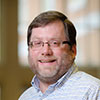This article is more than 5 years old.
In honor of last Sunday’s Super Bowl, I considered beginning and ending this post with, “I’m only writing this blogpost so I won’t get fined,” but I might have a bit more to share. But only a bit, unfortunately, because this will be a shorter than usual conference post from me, because I spent much of my time in Chicago sick as a dog.
I flew into town on Friday, January 30th, with a cold and an ear infection, and feared I might have ruptured my right eardrum, but by Saturday morning, my hearing had returned, and I felt somewhat better and ready to tackle the day. First up, I went to the meeting of one of my two committees, the Continuing Resources Cataloging Committee. We were planning for our committee forum on Monday, which got thrown into turmoil because our primary speaker had to cancel. We brainstormed ideas for questions and topics in an open forum, and had a lively discussion.
Luckily, my next big committee obligation, CC:DA (Catalog Committee: Description and Access) had a four-hour meeting scheduled in the same hotel, so I could just stay there. CC:DA, as I’ve mentioned before, develops ALA’s position on RDA. That means that we read and discuss proposed changes to RDA that come in from all sorts of constituencies. While it’s really interesting to see how the process works, it’s probably pretty boring to recount in too much detail here. I would like to briefly discuss one of the proposals we looked at, which was a proposal by the Task Force Machine-Actionable Data Elements to create a measurements element in RDA. The Task Force’s purpose is to develop data elements that are more easily understood and manipulated by computers. This measurements element sounds simple, but would actually represent a pretty radical re-thinking of how RDA works. The measurement element would have six sub-elements that would clearly define what was being measured and how. The six sub-elements are Measurement Type (thing like height, playing time, number of units, etc.), Measurement Unit (minutes, cm, cubic feet, etc.), Measurement Quantity (number of minutes, cm, etc.), Part Measured (when necessary), Measurement Qualifier (when necessary, especially for approximate measures), and Unstructured Measurement (a textual description of what is measured, if it can’t quite fit into the previous categories). This proposal is still in the early stages and has a long way to go before it will show up in actual changes to the RDA instructions, but it’s kind of interesting to know that this kind of thinking is going on. Or at least, it’s interesting to me.
After that meeting, I managed to scoot back to my hotel, where I was able to join a meeting of the Editorial Board of Serials Review (I’m a member) that was already in progress. I then went to an ALCTS reception, but started to feel very tired and bailed early. That night I felt my absolute worst of the trip, with chills and nausea. Jeff mentioned that he thought I was going to die. In truth, I asked him if he’d do me a favor and kill me.
After that night, the next day started very rough. I started to feel somewhat better by late Sunday morning and managed to do a little business in my role as president of NASIG. I went to a meeting with the rep from the publisher of the NASIG proceedings to talk about NASIG’s contract with them, as well as talking to some vendors on the exhibits floor to see if they’d be interested in exhibiting at the NASIG Conference in May.
On Monday morning, I went to the second, three-hour meeting of CC:DA. During the meeting, Mimi texted me to let me know that my 6 pm flight that day had been cancelled. I arranged to get on a 2:05 pm flight on standby, but had to leave the meeting a half-hour early to have any chance of making it. Luckily, I did, because I don’t know if I could have handled being stuck in Chicago another night.
Oddly enough, this actually wasn’t my worst-ever conference going experience. So at least there’s that.

3 Comments on ‘Steve at 2015 ALA Midwinter’
Steve, you are a trooper! (And I want to hear that story of your worst conference experience!)
Yours is the only post so far that hasn’t been shrouded in stories of snow. Yours is shrouded in sickness! Its impressive that you managed to be so very productive.
Yes, you are now my posterboy for perseverance in the face of adversity! And I’m glad Jeff didn’t take you up on your request 🙂